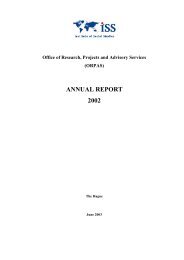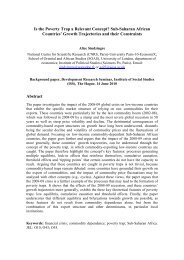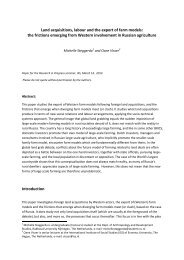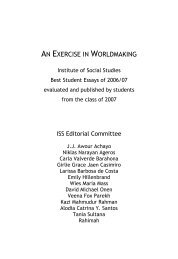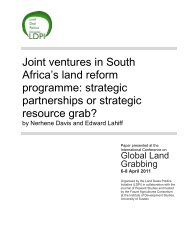AN EXERCISE IN WORLDMAKING 2009 - ISS
AN EXERCISE IN WORLDMAKING 2009 - ISS
AN EXERCISE IN WORLDMAKING 2009 - ISS
You also want an ePaper? Increase the reach of your titles
YUMPU automatically turns print PDFs into web optimized ePapers that Google loves.
200 CH<strong>AN</strong>TELLE DE NOBREGA<br />
The first two sections provide a definition of intersectionality and offer<br />
concrete ways in which intersectionality can improve human rights<br />
theory and praxis, with a particular focus on social exclusion, though it<br />
should be mentioned that this is not an exhaustive analysis. The final<br />
section provides three potential problems or critiques that the application<br />
of an intersectional framework could be confronted with, and uses<br />
these to further explain the strengths and advantages of intersectionality.<br />
<strong>IN</strong>TERSECTIONALITY<br />
Intersectionality refers to the interaction between and intersections of<br />
multiple identities, what Davis calls “categories of difference” (2008: 68),<br />
which are produced and reproduced – directly and discursively – in individuals,<br />
institutions, and social relations of power, as well as in cultural<br />
ideologies and social practices. These intersections result in complex and<br />
multi-dimensional experiences of oppression, power, privilege and<br />
domination, and their attendant consequences, such as violence and discrimination.<br />
The term was first coined in 1989 by Crenshaw (Davis 2008:<br />
68), who differentiated between structural and political intersectionality.<br />
Structural intersectionality is when individuals “are situated within<br />
overlapping structures of subordination” so that the reality of multiple<br />
hierarchies results in complex and compounded effects, as these multiple<br />
systems of oppression interact with one another (Crenshaw 1993: 114).<br />
For example, a Native American woman who is the victim of intimate<br />
partner violence not only experiences this violence as a woman, but also<br />
as a member of a racial minority where there are particular and specific<br />
cultural expectations and gendered norms. In addition, she may find that<br />
women’s shelters are unable to communicate effectively with her due to<br />
language barriers, or that the relative geographic and social isolation of<br />
Native American communities could result in difficulty of access to<br />
health and support services. She therefore experiences additional discrimination<br />
based on race, ethnicity and language, which compounds and<br />
changes the reality of how gender-based violence impacts her.<br />
Political intersectionality refers to the way that political and legal discourses<br />
and rhetoric “erase” particular individuals and communities by<br />
highlighting or “favouring” specific forms of subordination or discrimination<br />
at the expense of others (Crenshaw 1993: 115-116). Thus, following<br />
on from our earlier example, if the dominant voices in the political<br />
arena are those of white, middle-class women, they are likely to speak to




